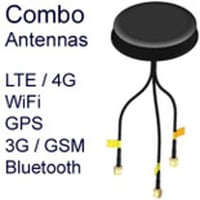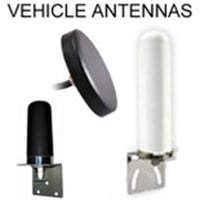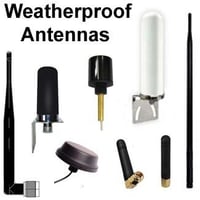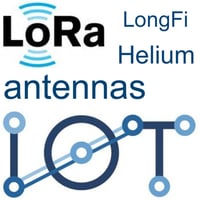MultiBand 698-2800MHz
MultiBand Antennas (698 - 2800MHz):
Multiband antennas are radio frequency antennas that have been designed to operate across a range of radio frequency bands, each band being made up of several channels or individual frequencies.
MultiBand Antennas are of frequency range 698-2800MHz that you can use for all manner of wireless cellular and GPS applications. Multiband antennas add utility and roaming capability to devices where globally recognized cellular technologies like GSM and LTE are used. When purchasing a cellular antenna, attention should be paid to the specific frequencies supported by the antenna, to ensure that compatibility issues when it is used. As with all antennas, attention should be paid to antenna characteristics such as gain, polarization, antenna pattern, impedance (usually 50 ohms), directivity as well as the connectors, cables, and mounting needed to ensure that the antenna is the most appropriate choice for your application.
Applications include:
- Omnidirectional multiband antennas that work in the 698-960 MHz and also the 1710-2700 MHz frequencies. These include outdoor weatherproof and indoor applications with low angle radiation and wide bandwidth. They are usually ideal for 3G GSM and 4G applications where no metal surface or ground plane is available.
- Omnidirectional dual-band MIMO antennas which work on both the 698-960 MHz and the 1710-2700 MHz frequencies at the same time. These are great for a 4G/LTE & GPS Combo and can also be used for both outdoor and indoor applications given its superior traditional gain and low angle radiation pattern.
- Dual-band 4G LTE antenna, puck style, permanent mount, with main/div (main / AUX) connections and 6-ft cable to SMA-male connector.
- Multiband/Dual band antennas which are omnidirectional dipole antennas that operate in the 850-900 MHz frequencies and the 1800-2100MHz frequency. This band is used for GSM (Global System for Mobile Communication). In this regard, it works with 2G networks and is for the most part used for wireless video links, SCADA, RFID, GSM, 860-960MHz cellular phone band, Non-Line of Sight and in the 900MHz ISM band.
- Marine grade Omni-Directional Multi-band Antenna that works between the 698-960MHz and the 1710-2700MHz frequencies. This works efficiently between 698-960MHz and 1710 and 2700MHz and works well with 2G, GSM networks for things such as flip phones, 3G, 4G, and also GPS/BEIDOU/GLONASS networks to control marine communications and transmissions.
A multiband antenna may be internalized with PCB mounted, chip, or planar inverted F-type multiband antennas being common. For these internal antennas, bandwidth and gain will vary depending on the amount of space available to the antenna within the device. External multiband antennas can be attached to a device via a suitable connector and coaxial cable to provide enhanced coverage where and when needed. There are several types of multiband antennas commonly available:
- dual-band, supporting 2 frequency bands
- tri-band, supporting 3 key frequencies
- quad-band, active across 4 frequency bands
- penta-band resonant at up to 5 frequency bands
Structure of multiband antennas
Multiband antennas are essentially made up of multiple smaller antennas or narrowband components. They are composite structures. Though the antenna may be a single physical unit, it is actually composed of separate resonant units, each of which is active at a specific frequency. This means particular portions of the antenna will be active at particular frequency bands. For example, many multiband antennas will have low-band, mid-band, and high-band structures within them that have specific center frequencies according to the coverage required.
This is often achieved using wires, loops, folded loops or coils of varying caliber inside the antenna, to suit the targeted frequencies. If frequency bands supported by the antenna are spaced widely apart, parallel radio frequency circuits are created within the antenna which of course impact size, cost and energy consumption.
Because multiple frequencies are supported by a single antenna, overall antenna gain may be lower than an equivalent single band antenna at each frequency. These units may also be larger than single-band antennas to accommodate the circuitry needed for serving multiple bands.
A cellular multiband antenna supports the key frequencies for cellular communication and is typically used for roaming across geographic territories where cellular telecommunication technologies and frequencies are likely to vary. Users can retain connectivity on their handset or device while outside the coverage of their usual or 'home' cellular network by using a multiband antenna to access cellular networks in the visited region. This type of antenna may also be desirable for signal enhancement and support of functionality beyond regular voice calls including:
- Mobile internet
- Voice over internet protocol (VoIP)
- Video calling
- Mobile TV
In addition, the frequencies supported by multi-band antennas may support non-cellular technologies such as WiFi, Bluetooth, and GPS by being able to receive and transmit at the appropriate frequency.
Frequency coverage of cellular multi-band antennas
Depending on the configuration of the antenna, multiband antennas are usually active at cellular frequencies found anywhere between 680 MHz and 2900 MHz. The frequency bands the antenna is tuned to will vary depending on the number or spread of bands offered but typically covered include:
- 824–894 MHz known as GSM850, and can also be used by CDMA(cdma 850)
- 880–960 MHz known as GSM900
- 1710–1880 MHz known as GSM1800
- 1850–1990 MHz known as GSM1900
- 1920–2170 MHz, the UMTS frequency band
- 2305–2400 MHz which supports LTE2300
- 2500–2690 MHz which supports LTE2500
Significance of cellular multiband antennas
The continually broadening range of wireless communication technologies has necessitated increasing utilization of the radio frequency spectrum, often by several devices or different components within a single device. In addition, licensing and regulation of the radio spectrum by Governmental agencies have led to regional variations in how wireless connectivity and telecommunication technologies operate. In the absence of a globally harmonized approach to the distribution and use of the main frequency bands, a multiband antenna remains an essential means of attaining cellular connectivity in a range of environments and across the major cellular communication standards and wireless carriers. Multiband capability is now expected as standard for most 3rd and 4th generation/ LTE devices, so these antennas are in demand. A multiband antenna is now also necessary to take simultaneous advantage of non-cellular technologies like WiFi and Bluetooth that mobile devices will be capable of using. Without multiband antenna technology, a single frequency antenna would be needed for each type of mobile communication service.
How do cellular networks work?
Over five decades, cellular technology has advanced to deliver wireless networking with the speed, capacity, and infrastructure needed to support the high volumes of data transfer expected for contemporary mobile communications. These networks have also expanded worldwide with some form of coverage available in almost every inhabited part of the Earth. Cellular networks evolved from the original analog telephone networks but are characterized by the last link in the network being wireless rather than cabled. A service area is made up of a network of strategically located base stations, each complete with arrays of powerful cellular antennas. These base stations perform as fixed location transceivers to provide the necessary connectivity and coverage needed by network users.Neighboring base stations transmit and receive at slightly different frequencies to prevent interference and ensure that the service is robust. Using this technique large territories can be efficiently covered with a functioning high-capacity network.
Main cellular communications technologies supported by multi-band antennas.
[A] GSM
GSM is an abbreviation for the Global System for Mobile Communications. This is a European cellular connectivity standard that specifies the functioning of 2nd generation digital cellular networks. It was originally released in the early 1990s as an upgrade from analog 1st generation cellular networking, but underwent a significant expansion after 2010, becoming a global standard. Alongside voice telephony, this circuit-switched digital network is able to provide data transport via General Packet Radio Service (GPRS), or Enhanced Data Rates for GSM Evolution (EDGE). GSM networks are built on a base station subsystem. Individual cell size can vary between hundreds of meters and kilometers in diameter depending on the location and density of base stations.
GSM operates across a range of carrier frequencies, usually either at 900 MHz or 1800 MHz. In regions where these frequency bands are already occupied the 850 MHz and 1900 MHz bands are used to support GSM instead.
[B] CDMA
Code-Division Multiple Access is a cellular technology that facilitates multiple users to access a frequency band by enabling simultaneous use by several transmitters. It is used in several cellular networking standards and has been upgraded with the progress of 3G. Spread spectrum technology and coding of individual transmitters are used to prevent the overlapping gsm antennas experiencing the interference that would normally be expected from doing this.
CDMA operates at 824 MHz to 894 MHz. CDMA was used widely in the US by mobile networks like Sprint and Verizon but is being gradually phased out. In the majority of regions where there is CDMA Vs LTE, CDMA has been overtaken.
GSM vs CDMA: Main differences
Though GSM and CDMA can both operate in the 824 MHz to 894 MHz frequency band, they are distinct technologies and use different techniques to achieve multiple access connectivity. A major difference between CDMA and GSM is that CDMA is notable for not requiring a SIM card. Globally, GSM has greater coverage being available in at least 150 countries and with many more carriers than CDMA. Data speeds are also faster with GSM; 42Mbps for GSM versus 3.6Mbps with CDMA. CDMA is unable to simultaneously support telephony and data transmission.
[C] UMTS
This cellular technology is also known as the Universal Mobile Telecommunications System and is based on the GSM standard. It is a third-generation technology that is developed and overseen by the Third Generation Partnership Project (3GPP) and is part of the International Telecommunications Union IMT-2000 standard. UTMS uses a wideband variant of CDMA, known as wcdma, to provide operators with greater bandwidth and more efficient use of its frequency bands. It operates at a higher frequency than the second generation technologies: 1920–2170 MHz.
[D] LTE
Long-Term Evolution is based on existing GSM and UMTS networking and is a progression of these technologies. It has been largely successful, with over 350 commercial LTE networks operating globally. It has been developed by the 3GPP and provides a route for upgrading existing cellular networking and infrastructure, using digital signal processing to provide greater speeds and capacity for cellular communications. The network architecture of LTE is IP-based. This internet protocol method of data transfer has vastly reduced latency and facilitates the transfer of much larger data packets than GSM and UMTS.
LTE uses many frequency bands, with spectrum allocations varying between countries. This makes LTE antenna types with multiband properties essential for international roaming if a GSM LTE phone is used.
There are over 40 frequency bands that LTE can use which each vary in bandwidth. An LTE antenna will need to be checked against the local frequencies where it will be used. Notable bands include:
- (B12/13) LTE 700
- (B28) LTE 700
- (B20) LTE 800
- (B5) LTE 850
- (B8) LTE 900
- (B4) LTE AWS 1700
- (B3) LTE 1800
- (B2) LTE 1900
- (B1) LTE 2100
- (B7) LTE 2600
LTE frequency bands can be used in two ways:
- Frequency Division Duplex (FDD) which uses separate bands for the uplink and downlink connection.
- Time Division Duplex (TDD) operates over a single band with a temporal spacing between uplink and downlink.
LTE vs 4G
Both 4G and LTE represent major advancements in the capacity and efficiency of data transfer across cellular networks. Though the increased speeds and performance may provide a similar consumer experience, 4G and LTE are actually quite different and a 4g cell antenna may not always be LTE compatible.
4th generation cellular technology is the successor to 3G and is stringently defined by the Swiss-based International Telecommunications Union. The standards specify peak speeds of 100 megabits per second when mobile and up to 1 gigabit per second when stationary, facilitating high mobility communication, internet access, streaming, and gaming.
LTE preceded the publication of the 4G protocol and is not fully compliant with it, despite the marketing by cell phone companies. The main practical difference between the two technologies is speed; LTE is not yet able to achieve 4G speeds, which themselves may only be theoretical.
Frequently asked questions
What is a hepta-band antenna?
A hepta-band antenna operates across 7 frequency bands that provide coverage for:
- Global Positioning System (GPS)
- Advanced Wireless Services (AWS)
- Global System for Mobile Communications (GSM)
- Universal Mobile Telecommunications System (UMTS)
- Wireless Local Area Networks (W-LAN)
- Wireless Internet Service Providers (WISP)
They are typically omnidirectional antennas that are used to facilitate roaming across different regions where cellular networking protocols are likely to vary. This enables the device to which it is attached to use telephony and mobile internet services in different regions and may even function as a WiFi antenna.
The typical spread of frequencies is:
- 824-894 MHz (GSM/CDMA)
- 880-960 MHz
- 1575 MHz (GPS)
- 1710-1880 MHz
- 1850-1990 MHz
- 1920-2170 MHz
- 2400-2500 MHz
Within this 824 to 2500 MHz frequency range ISM bands are also included.
Can I use a multiband antenna in every country?
One of the key reasons for obtaining a multiband antenna is to avoid having to change antennas according to each country's frequency bands. A high-quality multiband antenna should support the leading technologies and frequencies used by carriers across the world as discussed above especially if it is GSM, 4G, and LTE compatible. A high-quality multiband antenna is a prudent acquisition for international logistics and IoT-based projects which can also provide GPS and WiFi coverage alongside the main cellular technologies, meaning networking can move with freight and cargo without loss of connectivity.
LEARN MORE:
- 5G, 4G, and 3G standards
- Dual-band antennas
- Combo antennas







